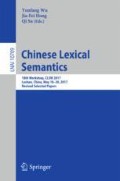Abstract
Chinese accompanying gestures are a common phenomenon in life, and native speakers of Chinese use gesture modality to express metaphors. This study analyzes metaphors in Chinese accompanying gesture modality from the perspective of cognitive linguistics and cognitive neuroscience rather than the multimodal metaphor theory. Both spoken language and accompanying gesture modalities of metaphors are integrated into discourse, indicating that metaphor creation is based on general cognitive rather than linguistic features. The case study of Chinese accompanying gestures shows that conceptual metaphors can be cognitively activated when they are not expressed in oral modality. The close interaction between modality and language indicates that metaphors are a dynamic attribute rather than a static in the physical and interactive context. The study of metaphors in accompanying gesture modality provides a specific case for further studies on metaphors and offers support for creating a non-literal language cognitive model.
Access this chapter
Tax calculation will be finalised at checkout
Purchases are for personal use only
Preview
Unable to display preview. Download preview PDF.
References
Hu Zhuanglin. Multimodalization in Social Semiotics .Language Teaching and Linguistic Studies(in Chinese). 1 (3): 1-10(2007).
Calbris G. The semiotics of French gestures. Indiana Univ Press (1990).
McNeill D. Hand and mind: What gestures reveal about thought. University of Chicago Press (1992).
Okrent A. A modality-free notion of gesture and how it can help us with the morpheme vs. gesture question in sign language linguistics (or at least give us some criteria to work with). Modality and structure in signed and spoken languages, 175-198(2002).
Cienki A. Metaphoric gestures and some of their relations to verbal metaphoric expressions. Discourse and cognition: Bridging the gap, 189-204(1998).
Müller C. Metaphors. Dead and alive, sleeping and waking. A cognitive approach to metaphors in language use. Unpublished Habilitationsschrift, Freie Universität Berlin, Germany (2004).
Núñez R, Sweetser E. Spatial embodiment of temporal metaphors in Aymara: Blending source-domain gesture with speech//7th International Cognitive Linguistics Conference. 249-250(2001).
Wundt W M. Völkerpsychologie; eine untersuchung der entwicklungsgesetze von sprache, mythus und sitte: Bd. Die Kunst. W. Engelmann (1908).
Kendon A. Gesticulation and speech: Two aspects of the process of utterance. The relationship of verbal and nonverbal communication, 25: 207-227(1980).
McNeill D. So you think gestures are nonverbal? Psychological review, 92(3): 350(1985).
Murphy G L. Reasons to doubt the present evidence for metaphoric representation. Cognition, 62(1): 99-108(1997).
McNeill D. Language and gesture. Cambridge University Press (2000).
Goldin-Meadow S. Hearing gesture: How our hands help us think. Harvard University Press (2005).
Lakoff G, Johnson M. Metaphors we live by. University of Chicago press (2008).
Müller C. Forms and uses of the Palm up Open Hand: A case of a gesture family. The semantics and pragmatics of everyday gestures, 234-256(2004).
Lakoff G, Turner M. More than cool reason: A field guide to poetic metaphor. University of Chicago Press (2009).
Forceville C. Pictorial metaphor in advertising. Psychology Press (1996).
Feyereisen P. Gestures and speech, interactions and separations: A reply to McNeill (1985).
Charman T, Swettenham J, Baron-Cohen S, et al. Infants with autism: an investigation of empathy, pretend play, joint attention, and imitation. Developmental psychology, 33(5): 781(1997).
20. Halsband U, Schmitt J, Weyers M, et al. Recognition and imitation of pantomimed motor acts after unilateral parietal and premotor lesions: A perspective on apraxia. Neuropsychologia, 39(2): 200-216(2001).
Kendon A. Gesture and speech: How they interact. Nonverbal interaction, ed. by JR Wiemann & Randall Harrison. Beverly Hills (1983).
Krauss R M, Chen Y, Gotfexnum R F. 13 Lexical gestures and lexical access: a process model. Language and gesture, 2: 261(2000).
Kita S. How representational gestures help speaking. Language and gesture, 162-185(2000).
De Ruiter J. The production of gesture and speech. Language and gesture (2000).
Kendon A. Gesture: Visible action as utterance. Cambridge University Press (2004).
Kita S, Özyürek A. What does cross-linguistic variation in semantic coordination of speech and gesture reveal? Evidence for an interface representation of spatial thinking and speaking. Journal of Memory and language, 48(1): 16-32(2003).
Kendon A. Some relationships between body motion and speech. Studies in dyadic communication, 7: 177(1972).
Levelt W. JM (1989). Speaking. From intention to articulation. MA: The MIT Press, Cambridge (1981).
McNeill D, Duncan S D. Growth points in thinking-for-speaking. Language and Gesture (1998).
Butterworth B, Hadar U. Gesture, speech, and computational stages: a reply to McNeill. Psychological Review, 1: 168(1989).
Chen Hua, Gu Yan, Zuo Han. Theories on the Relationship between gesture and speech – also on Implications for cognitive linguistics. Journal of Foreign language (in Chinese), (5): 50-58(2013).
Bavelas J B, Chovil N, Lawrie D A, et al. Interactive gestures. Discourse processes, 15(4): 469-489(1992).
McNeill D, Levy E T. Cohesion and gesture. Discourse processes, 16(4): 363-386(1993).
Kendon A. Gestures as illocutionary and discourse structure markers in Southern Italian conversation. Journal of pragmatics, 23(3): 247-279(1995).
Müller C. Redebegleitende Gesten: Kulturgeschichte, Theorie, Sprachvergleich. Spitz (1998).
Gibbs Jr R W, Berg E A. Mental imagery and embodied activity. Journal of Mental Imagery (2002).
Langacker R W. Foundations of cognitive grammar, vol. 2. Descriptive application (1991).
Cienki A. Metaphor in the ‘‘Strict Father’’and ‘‘Nurturant Parent’’cognitive models: Theoretical issues raised in an empirical study. Cognitive Linguistics, 16(2): 279-312(2005).
Cienki A, Müller C. Metaphor, gesture, and thought. The Cambridge handbook of metaphor and thought, 483-501(2008).
Author information
Authors and Affiliations
Corresponding author
Editor information
Editors and Affiliations
Rights and permissions
Copyright information
© 2018 Springer International Publishing AG
About this paper
Cite this paper
Yao, D., Jiang, M., Abulizi, A., Hou, R., Shu, L. (2018). Metaphors in Chinese Accompanying Gesture Modality and Cognition. In: Wu, Y., Hong, JF., Su, Q. (eds) Chinese Lexical Semantics. CLSW 2017. Lecture Notes in Computer Science(), vol 10709. Springer, Cham. https://doi.org/10.1007/978-3-319-73573-3_18
Download citation
DOI: https://doi.org/10.1007/978-3-319-73573-3_18
Published:
Publisher Name: Springer, Cham
Print ISBN: 978-3-319-73572-6
Online ISBN: 978-3-319-73573-3
eBook Packages: Computer ScienceComputer Science (R0)

